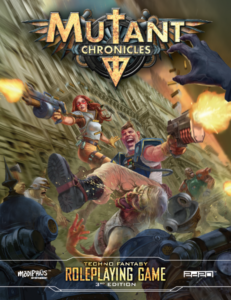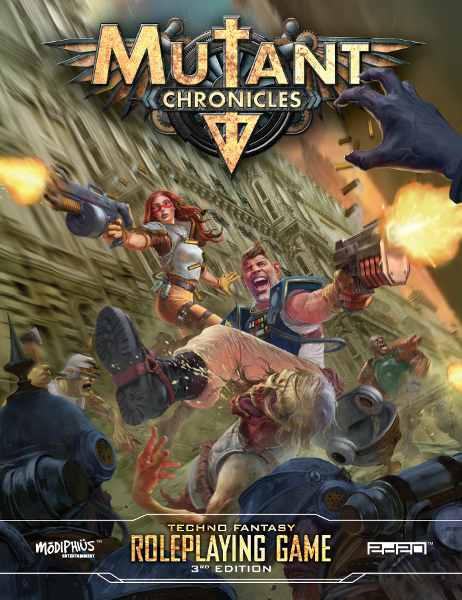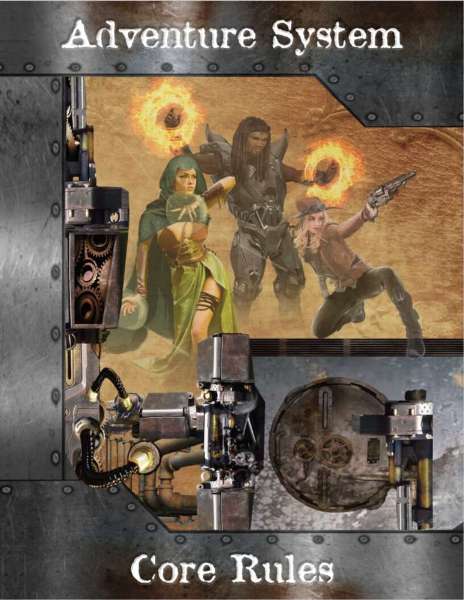
Mutant Chronicles
Mutant Chronicles is a dieselpunk role-playing game powered by 2d20, written by Jay Little, Nathan Dowdell, Chris Birch, Michal E Cross, Benn Beaton, John Dunn, Mischa Thomas, Gunnar Roxen, Dave Allen, Tom McGrenery, Chris Lites, Josh Vogt, Alex Bund, and Bastian Soijer and published by Modiphius Entertainment.
By Aaron T. Huss

Learn more about Mutant Chronicles here
Purchase Mutant Chronicles here
Find other Mutant Chronicles posts here
Mutant Chronicles is another big book role-playing game featuring a big setting. The Mutant Chronicles setting is an expansive, large-scale setting akin to Warhammer 40k and Star Wars, but isolated to our Solar System. And like many other large-scale settings, Earth has been all but laid to waste and the setting pushes life outward from there. Modiphius titles it as “techno fantasy”, but I would go a bit deeper and call it a dark fantasy game skinned with dieselpunk aesthetics; the dark fantasy aspects come from the widespread darkness that invades the Solar System, filled with beings often found in dark fantasy settings; the dieselpunk comes from the technology that powers the sci-fi aspects of the setting mixed with a bit of cyberpunk design (i.e. corporations and major organizations hold all the power). The “diesel” aesthetics are a direct result of the events that occur in the setting. Technology had advanced, “intelligent” weapons were created, they became “corrupted” by dark energy, and humankind has had to revert to more trustworthy equipment. It’s actually a pretty cool concept and is fully rolled into the setting. The setting itself is built around a timeline, like most large-scale settings, that is incredibly detailed and cannot be properly summarized. Just know that humankind rises to a great level, falls due to dark powers, and is rebuilding to fight back against these dark powers. If you want more details, you’ll really have to read the book because even a proper summary would be pages long.
Mutant Chronicles joins Infinity The Roleplaying Game as another Modiphius big book RPG. It is really three books in one covering the core rules, the setting, and a GM’s guide. All of this is powered by the very familiar 2d20 system Modiphius has incorporated into multiple games they publish. I personally am a fan of the 2d20 system and how Modiphius constantly keeps it fresh by altering it just enough to weave itself through the setting it is representing. As with other 2d20 games, Mutant Chronicles uses the familiar dice, Attributes, Skill & Talent trees, and Momentum. It also adds Chronicle Points to give PCs an edge and Dark Symmetry Points to hinder the PCs to represent the dark aspects of the setting. Continuing with the hero/horror aspects, you also have mental strain, madness, and corruption contrasting the lightness which represents the magic-like aspects of the system.
There is also one aspect of this implementation of the 2d20 system that needs highlighting – Lifepaths. Creating a character is not a matter of hammering out stats and trying to power game your way to the most optimal character build. Instead, you are presented with points and random-roll tables to build and flesh-out the various aspects of your character. This is similar to how character creation works in Traveller and you can determine faction, heritage, events, social status, career, environment, region, and quite a bit more. The unfortunate part about this method is that you may end up with something you don’t really want. Well, just hand that over to the GM as an NPC and start over. You can also roll-up your character and suddenly one of your events is that you were fired from your career… maybe that didn’t go as planned. Regardless, it definitely creates a plethora of random characters or you can pay some Life Points periodically to choose which aspect you don’t want to roll.
The size of the book may be a bit daunting, but players really only need to devote themselves to half the book if they don’t want to learn all the nuances of the setting. There are literally over 150 pages dedicated to the setting including gazetteer of Luna (where humanity now thrives), the major corporations and organizations, and what it means to be employed. Is this important? Well, some players may really enjoy it and really get into the nitty gritty aspects of the setting. Others may get quickly overwhelmed and only want to concern themselves with what it means to create and be a character. For the latter, stop at page 264 and you’re good to go! Of course, there may also be GMs that want to keep all this information away from the prying eyes of the players. That way there are many secrets that can be held back and the players only know the basic facts. This could actually be used from some intriguing gameplay that covers an entire campaign.
Of course, there are additional chapters dedicated to the GM and providing him or her with guidance on running the setting, adventures, and campaigns. Including, of course, adversaries and a bunch of information in the appendices.
So how does the book look? Well, you can tell it contains a combination of old and new artwork (this is the third edition of Mutant Chronicles). While it’s a great throwback to use old artwork, you can tell the re-used artwork is very old and doesn’t look nearly as nice as the new artwork. I personally do not like the re-used artwork and find some of it to be a poor representation of the setting. The new artwork looks amazing and really shows-off all the coolness of the setting and what the dieselpunk aesthetic looks like! Of course, this is just a personal preference and has no bearing on the quality of the book as a whole. The book is incredible, the setting is quite interesting, and the game system is full of possibilities!
Overall, Modiphius did an amazing job bringing Mutant Chronicles back to life and I can’t wait to see what’s inside all those supplements!



